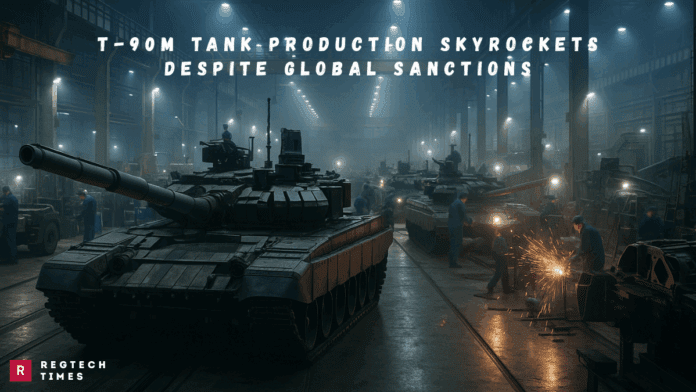Russia has dramatically increased the production of its most advanced main battle tank, the T-90M “Proryv”, even as it faces strict sanctions from Western countries. The country’s state-owned manufacturer Uralvagonzavod began producing these tanks around the clock, marking a sharp shift in how Russia plans to fight long wars on land.
According to a recent report, production of the T-90M has tripled compared to 2020–2021. At current speeds, Russia may be able to build up to 1,000 tanks each year by 2028. This huge increase comes at a time when Russia has already used up most of its older tanks in the ongoing war in Ukraine. It shows that Russia is focusing on keeping its tank forces strong despite high losses on the battlefield.
Before the full-scale invasion of Ukraine, Russia had about 400 earlier versions of the T-90. In 2020, the first T-90M units rolled off the production line. Around 66 to 85 tanks were delivered before the war began. Since then, production has sped up fast—60 to 70 tanks were made in 2022, 140 to 180 in 2023, and up to 300 units are expected in 2024. This growth has been tracked using satellite images and open-source information. The factory now works 24 hours a day to meet demand.
What Makes the T-90M Proryv Different?
The T-90M is Russia’s most modern tank in serial production today. It is built for serious combat and has several upgrades over older models. One of the biggest changes is a newly designed turret with strong multilayer armor. It also comes with Relikt explosive armor, which helps protect it from rockets and other attacks. In addition, many tanks now have anti-drone screens, showing how modern threats are changing tank design.
This tank runs on a powerful 1,130-horsepower diesel engine, making it faster and more reliable for long operations. It still uses the Sosna-U sight, an advanced system that helps the gunner aim better. Unlike some other Russian tanks, the T-90M has not been hit hard by sanctions when it comes to its main electronic systems.
Another important feature is its digital fire control system, which helps crews fire more accurately in battle. It also has better situational awareness tools, allowing soldiers inside the tank to understand what’s happening around them more clearly.
Even though it has less armor than top Western tanks like the Leopard 2A6 or M1A2 Abrams, the T-90M is faster, easier to fix, and cheaper to build. Its design focuses on being practical and mass-producible during wartime. This approach is very different from Russia’s more high-tech but complicated Armata tank, which has seen very limited production so far.
A New Focus on Homegrown Military Power
Russia’s new focus on the T-90M shows how it is adjusting to the challenges of war, sanctions, and industrial limits. The country has already lost over 3,000 tanks since the beginning of the Ukraine invasion in 2022. With older tanks like the T-90A and T-80BVM becoming harder to produce or maintain, Russia is leaning more on the T-90M as its main battle tank going forward.
Trump’s G9 Plan With China and Russia—A Risk to Western Unity?
Unlike the T-80BVM, which uses a gas turbine engine that is harder to mass-produce, the T-90M’s diesel engine makes it a better choice for scaling up production. The government is also investing in new tenders and expanded factory infrastructure, aiming to boost the tank-building process even more.
Many of the tanks being produced now are entirely new builds, rather than upgrades of older models. This means Russia is not just fixing old tanks—it is making brand-new ones in large numbers. Uralvagonzavod, the factory behind these tanks, is working at nearly full capacity to meet these growing demands.
This ramp-up in tank production highlights a clear shift in strategy. Even while facing international isolation and sanctions, Russia is using its domestic resources to keep its military forces equipped and ready. The T-90M “Proryv” is now at the center of this effort, showing how Russia is adapting its defense production under pressure.


